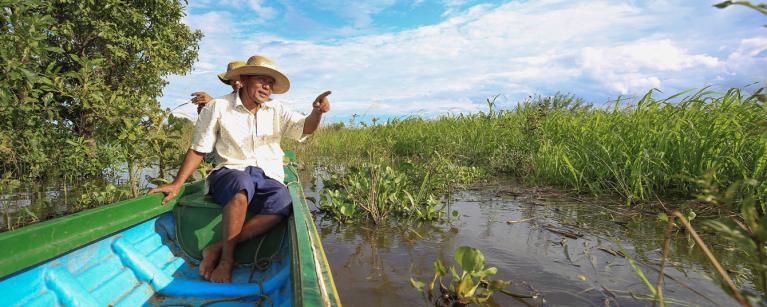How can fishing communities on Cambodia’s Tonle Sap Lake cope with changing rainfall patterns, lower water levels, and deforestation? Chris Hufstader reports on Oxfam’s work with groups in Cambodia to help people adapt and survive.
If you want to see the forest outside Prek Toal in July, it’s best to take a boat. The forest is inundated by Cambodia’s great lake, Tonle Sap, which expands and floods the forest in the rainy season.
Chea Saren visits frequently in his role leading the community fishery committee, which is tasked with protecting this sensitive area. On this day, he blasts along a channel of water in a narrow wooden boat powered by a long-shaft outboard motor, his broad-brimmed hat pulled down firmly. He stops within a special protected area of the flooded forest, where logging and fishing are banned.
The top halves of the trees are visible above the water, which Saren affirms is lower than normal these days. “In the past it has been six to seven meters [19 or 22 feet] deep,” he says, drifting near a stand of trees in the protected area. “Now we are just seeing [the water] come up three or four meters at its highest.” Saren says the lack of water in the lake, attributed to changing rainfall patterns due to climate change, as well as dams in the major tributaries to the lake (like the Mekong River) is affecting fish migration patterns.
Saren also sees the trees as a crucial resource. “The loss of the flooded forest is the greatest threat. The forest holds carbon, it’s a breeding place for fish, and [it] protects us from strong winds.” And when forests are either cut down or not submerged, Saren says fish lose their breeding areas. “This is why species like the giant catfish are disappearing,” he says.
WELCOMING TOURISTS
Finding alternatives to fishing not only takes some of the pressure off the fish resources in the lake, it also keeps people from having to migrate in search of work. FACT, Oxfam, and other partners in and around Tonle Sap are forming eco-tourism committees in picturesque towns where visitors can tour the lake and the flooded forest, stay in a floating home, and enjoy fresh local foods while gaining an appreciation of the sensitive environment around the lake.
In Kampong Phluk, about an hour from the tourist center Siem Reap, tourists can visit a 50-foot boat/restaurant at the mouth of a river, have a meal, and go for a boat ride on the lake or board a 14-footer paddled by a local guide for a tranquil four-kilometer tour in the flooded forest.
